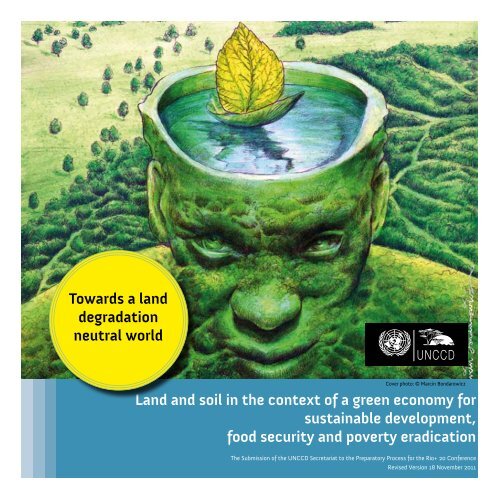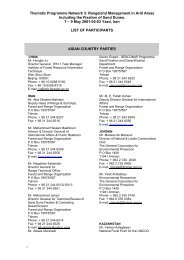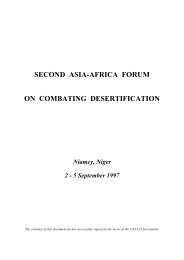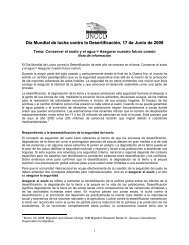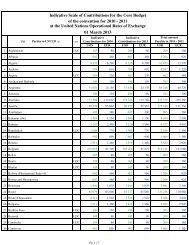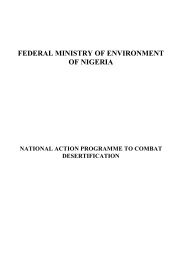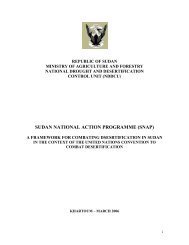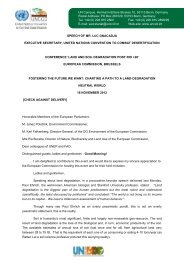Land and soil in the context of a green economy for ... - UNCCD
Land and soil in the context of a green economy for ... - UNCCD
Land and soil in the context of a green economy for ... - UNCCD
Create successful ePaper yourself
Turn your PDF publications into a flip-book with our unique Google optimized e-Paper software.
Towards a l<strong>and</strong><br />
degradation<br />
neutral world<br />
Cover photo: © Marc<strong>in</strong> Bondarowicz<br />
<strong>L<strong>and</strong></strong> <strong>and</strong> <strong>soil</strong> <strong>in</strong> <strong>the</strong> <strong>context</strong> <strong>of</strong> a <strong>green</strong> <strong>economy</strong> <strong>for</strong><br />
susta<strong>in</strong>able development,<br />
food security <strong>and</strong> poverty eradication<br />
The Submission <strong>of</strong> <strong>the</strong> <strong>UNCCD</strong> Secretariat to <strong>the</strong> Preparatory Process <strong>for</strong> <strong>the</strong> Rio+ 20 Conference<br />
Revised Version 18 November 2011
The importance <strong>of</strong> productive l<strong>and</strong>/fertile<br />
<strong>soil</strong> <strong>for</strong> susta<strong>in</strong>able development<br />
<strong>L<strong>and</strong></strong> 1<br />
is def<strong>in</strong>ed as a system engaged <strong>in</strong> generat<strong>in</strong>g biological<br />
productivity. It is <strong>the</strong> earth’s <strong>in</strong>frastructure <strong>for</strong> life. The rate <strong>and</strong><br />
quality <strong>of</strong> production generated from <strong>the</strong> l<strong>and</strong> depends on its major<br />
components, <strong>soil</strong> <strong>and</strong> its fertility. Soil organic matter, derived from <strong>the</strong><br />
vegetation supported by a particular <strong>soil</strong>, is <strong>the</strong> major component that<br />
controls <strong>soil</strong> fertility.<br />
<strong>L<strong>and</strong></strong> <strong>and</strong> <strong>soil</strong> not only support direct users but also <strong>in</strong>direct users,<br />
i.e. <strong>the</strong> consumers <strong>of</strong> l<strong>and</strong> productivity, <strong>the</strong> entire human population<br />
derives benefits generated by <strong>soil</strong> such as vegetation cover,<br />
atmospheric oxygen, climate regulation <strong>and</strong> water filtration provisions.<br />
Soil functions <strong>and</strong> services acquire <strong>the</strong> status <strong>of</strong> a global common<br />
whose protection benefits all. It requires partnership <strong>and</strong> cooperation<br />
at <strong>the</strong> global scale to prevent l<strong>and</strong> <strong>and</strong> <strong>soil</strong> degradation.<br />
The degradation <strong>of</strong> l<strong>and</strong> is a major threat to life on earth, <strong>in</strong>clud<strong>in</strong>g<br />
<strong>for</strong> humans. When occurr<strong>in</strong>g <strong>in</strong> dryl<strong>and</strong>s, where productivity is<br />
constra<strong>in</strong>ed by water, l<strong>and</strong> degradation is termed desertification. <strong>L<strong>and</strong></strong><br />
degradation results from various factors <strong>in</strong>clud<strong>in</strong>g human activities<br />
<strong>and</strong> climatic variation <strong>in</strong>duced disasters such as drought <strong>and</strong> floods. It<br />
is expressed by a persistent reduction <strong>of</strong> biological productivity, driven<br />
by overexploitation <strong>of</strong> l<strong>and</strong> resources by users striv<strong>in</strong>g to <strong>in</strong>crease<br />
economic productivity, which results <strong>in</strong> fertility loss <strong>and</strong> <strong>soil</strong> depletion.<br />
Drivers <strong>of</strong> change such as population growth, <strong>in</strong>creased consumption<br />
<strong>and</strong> <strong>in</strong>equity generate excessive dem<strong>and</strong>s on l<strong>and</strong> productivity. This <strong>in</strong><br />
turn leads to l<strong>and</strong> degradation, whose repercussions, both biophysical<br />
<strong>and</strong> socio-economic, travel far. Repercussions can be local, transboundary<br />
<strong>and</strong> are <strong>of</strong>ten felt globally, impact<strong>in</strong>g global climate <strong>and</strong><br />
food security, caus<strong>in</strong>g significant health problems <strong>and</strong> fuell<strong>in</strong>g political<br />
<strong>in</strong>stability.<br />
Map: Potential <strong>for</strong> future drought worldwide: The world faces<br />
grow<strong>in</strong>g threat <strong>of</strong> severe drought<br />
Regions that are blue or <strong>green</strong> will likely be at lower risk <strong>of</strong> drought,<br />
while those <strong>in</strong> <strong>the</strong> yellow <strong>and</strong> violet spectrum could face more<br />
unusually-extreme drought conditions.<br />
(Source: University Corporation <strong>for</strong> Atmospheric Research (UCAR) National Center <strong>for</strong> Atmospheric<br />
Research (NCAR) & National Science Foundation http://www2.ucar.edu/news/2904/climatechange-drought-may-threaten-much-globe-with<strong>in</strong>-decades
“Upon this h<strong>and</strong>ful <strong>of</strong> <strong>soil</strong> our survival depends. Husb<strong>and</strong> it <strong>and</strong> it will grow our food, our fuel, <strong>and</strong> our shelter<br />
<strong>and</strong> surround us with beauty. Abuse it <strong>and</strong> <strong>the</strong> <strong>soil</strong> will collapse <strong>and</strong> die, tak<strong>in</strong>g humanity with it” 2<br />
The scope <strong>of</strong> <strong>the</strong> challenge<br />
Despite <strong>the</strong> crippl<strong>in</strong>g effects <strong>of</strong> l<strong>and</strong> degradation or <strong>soil</strong> nutrient<br />
depletion, <strong>the</strong> world has cont<strong>in</strong>ued build<strong>in</strong>g towards ‘a <strong>soil</strong> peak’<br />
which will have far-worse consequences than <strong>the</strong> current ‘oil peak’.<br />
Despite <strong>the</strong> search <strong>for</strong> susta<strong>in</strong>ability, <strong>the</strong> threats <strong>and</strong> far-reach<strong>in</strong>g<br />
impacts <strong>of</strong> l<strong>and</strong> degradation are ignored. The issue is still a bl<strong>in</strong>d spot<br />
<strong>for</strong> <strong>the</strong> <strong>in</strong>ternational community.<br />
Our most significant non-renewable geo-resource is productive l<strong>and</strong>/<br />
fertile <strong>soil</strong>. Never<strong>the</strong>less each year, an estimated 24 billion tons <strong>of</strong><br />
fertile <strong>soil</strong> are lost. Arable l<strong>and</strong> loss is estimated at 30 to 35 times<br />
<strong>the</strong> historical rate. <strong>L<strong>and</strong></strong> degradation directly affects 1.5 billion<br />
people globally. Worldwide, when poverty is assessed <strong>in</strong> terms <strong>of</strong><br />
<strong>in</strong>fant mortality rate, 74% <strong>of</strong> <strong>the</strong> poor (42% <strong>of</strong> <strong>the</strong> very <strong>and</strong> 32% <strong>of</strong><br />
<strong>the</strong> moderately poor) are directly affected by l<strong>and</strong> degradation.<br />
Desertification <strong>L<strong>and</strong></strong> Degradation <strong>and</strong> Drought have a disproportionate<br />
impact on woman <strong>and</strong> children. They bear <strong>the</strong> burdens <strong>of</strong> l<strong>and</strong><br />
degradation <strong>and</strong> are <strong>the</strong> last to leave <strong>the</strong>ir l<strong>and</strong>.<br />
<strong>L<strong>and</strong></strong> is a f<strong>in</strong>ite resource. <strong>L<strong>and</strong></strong> degradation depletes <strong>the</strong> resource base<br />
<strong>for</strong> our common food security. In <strong>the</strong> dryl<strong>and</strong>s, due to drought <strong>and</strong><br />
desertification, 12 million hectares <strong>of</strong> l<strong>and</strong> are trans<strong>for</strong>med <strong>in</strong>to new<br />
man-made deserts each year. That is an area with <strong>the</strong> potential to<br />
produce 20 million tons <strong>of</strong> gra<strong>in</strong> every year.<br />
Desertification <strong>and</strong> l<strong>and</strong> degradation are now pervasive <strong>in</strong> all<br />
ecosystems <strong>and</strong> corrode <strong>the</strong> three pillars <strong>of</strong> susta<strong>in</strong>able development. 3<br />
Most certa<strong>in</strong>ly l<strong>and</strong> degradation is a global phenomenon, with 78%<br />
<strong>of</strong> currently degrad<strong>in</strong>g l<strong>and</strong> found <strong>in</strong> non-dryl<strong>and</strong> areas. Degrad<strong>in</strong>g<br />
<strong>the</strong> buffer zone <strong>of</strong> <strong>the</strong> dryl<strong>and</strong>s also <strong>in</strong>creases dryl<strong>and</strong> vulnerability to<br />
degradation. The dem<strong>and</strong> <strong>for</strong> productive l<strong>and</strong> is high <strong>and</strong> competition<br />
over l<strong>and</strong> use is <strong>in</strong>tense. Recent food crises did not happen accidentally<br />
<strong>and</strong> are not over. In an <strong>in</strong>creas<strong>in</strong>gly <strong>in</strong>terdependent world, l<strong>and</strong>-related<br />
crises are ever more likely to mutate <strong>in</strong>to new global crises.<br />
Africa is <strong>the</strong> region most vulnerable to <strong>the</strong> phenomenon <strong>of</strong><br />
desertification. Over 45 per cent <strong>of</strong> Africa is affected by desertification.<br />
55 per cent <strong>of</strong> this area is at high or very high risk <strong>of</strong> fur<strong>the</strong>r degradation.<br />
2/3rds <strong>of</strong> Africa’s arable l<strong>and</strong> could be lost by 2025 if this trend<br />
cont<strong>in</strong>ues.<br />
As <strong>for</strong> drought, <strong>the</strong> percentage <strong>of</strong> <strong>the</strong> Earth’s l<strong>and</strong> area stricken by<br />
serious drought more than doubled between <strong>the</strong> 1970s <strong>and</strong> <strong>the</strong> early<br />
2000s. The world is fac<strong>in</strong>g <strong>the</strong> possibility <strong>of</strong> widespread drought <strong>in</strong><br />
<strong>the</strong> com<strong>in</strong>g decades. This fact has yet to be fully recognized by <strong>the</strong><br />
<strong>in</strong>ternational community. Un<strong>for</strong>tunately, drought, <strong>in</strong> our time, still<br />
implies fam<strong>in</strong>e <strong>and</strong> claims lives. The tragic situation happen<strong>in</strong>g <strong>in</strong> <strong>the</strong><br />
Horn <strong>of</strong> Africa is a stark rem<strong>in</strong>der that we still have a long way to go.<br />
In <strong>the</strong> last two decades, significant l<strong>and</strong> recovery <strong>and</strong> improvement<br />
have occurred <strong>in</strong> <strong>the</strong> dryl<strong>and</strong>s. In many cases, dryl<strong>and</strong>s populations<br />
have been lead<strong>in</strong>g <strong>the</strong>se <strong>in</strong>novations <strong>and</strong> progresses. For <strong>in</strong>stance,<br />
farmer-managed natural regeneration <strong>and</strong> agr<strong>of</strong>orestry techniques,<br />
such as plant<strong>in</strong>g <strong>of</strong> “fertilizer trees” on farml<strong>and</strong>s <strong>and</strong> graz<strong>in</strong>g l<strong>and</strong>s,<br />
have already been adopted <strong>in</strong> many regions. Such techniques have<br />
contributed to improv<strong>in</strong>g over six million hectares across Africa. A<br />
major scal<strong>in</strong>g-up <strong>of</strong> <strong>the</strong>se systems should be pursued everywhere by<br />
improv<strong>in</strong>g public policies <strong>and</strong> <strong>in</strong>stitutions <strong>and</strong> harness<strong>in</strong>g <strong>the</strong> potential<br />
<strong>of</strong> civil society <strong>and</strong> <strong>the</strong> private sector.<br />
At <strong>the</strong> same time, more than 2 billion hectares 4<br />
<strong>of</strong> l<strong>and</strong> worldwide is<br />
suitable <strong>for</strong> rehabilitation through <strong>for</strong>est <strong>and</strong> l<strong>and</strong>scape restoration.<br />
1.5 billion hectares would be best-suited to mosaic restoration, <strong>in</strong><br />
which <strong>for</strong>ests <strong>and</strong> trees are comb<strong>in</strong>ed with o<strong>the</strong>r l<strong>and</strong> uses, <strong>in</strong>clud<strong>in</strong>g<br />
agr<strong>of</strong>orestry, smallholder agriculture. This <strong>of</strong>fers “a vast opportunity<br />
to reduce poverty, improve food security, reduce climate change, <strong>and</strong><br />
conserve biodiversity”.
The Global Policy Response from <strong>the</strong> “Earth Summit <strong>in</strong> Rio” <strong>and</strong> its Agenda 21<br />
The UNFCCC, <strong>the</strong> CBD <strong>and</strong> <strong>the</strong> <strong>UNCCD</strong> (<strong>the</strong> Rio Conventions) are <strong>the</strong> <strong>of</strong>fspr<strong>in</strong>g <strong>of</strong> <strong>the</strong> Earth Summit held <strong>in</strong> Rio de Janeiro <strong>in</strong> 1992. While<br />
UNFCCC <strong>and</strong> CBD address <strong>the</strong> atmosphere <strong>and</strong> <strong>the</strong> diversity <strong>of</strong> life on earth respectively, <strong>the</strong> <strong>UNCCD</strong> addresses <strong>the</strong> degradation <strong>of</strong> <strong>the</strong> earth’s<br />
<strong>in</strong>frastructure <strong>for</strong> life - l<strong>and</strong>. <strong>UNCCD</strong> has a specific m<strong>and</strong>ate <strong>for</strong> <strong>the</strong> arid, semi-arid <strong>and</strong> dry sub-humid areas (collectively known as <strong>the</strong> dryl<strong>and</strong>s)<br />
where productivity is constra<strong>in</strong>ed by water.<br />
While <strong>the</strong> awareness <strong>of</strong> <strong>the</strong> global community to climate change <strong>and</strong> biodiversity loss has dramatically <strong>in</strong>creased s<strong>in</strong>ce <strong>the</strong> Rio Summit, <strong>the</strong><br />
significance <strong>of</strong> l<strong>and</strong> <strong>and</strong> <strong>soil</strong> to humanity rema<strong>in</strong> obscure to many. As a result, <strong>the</strong> risk to livelihoods emanat<strong>in</strong>g from l<strong>and</strong> <strong>and</strong> <strong>soil</strong> degradation<br />
does not receive <strong>the</strong> attention it deserves. This may be attributed, <strong>in</strong> part, to <strong>the</strong> limited textual m<strong>and</strong>ate <strong>of</strong> <strong>the</strong> <strong>UNCCD</strong> <strong>and</strong> its limited<br />
geographical focus. This has resulted <strong>in</strong> <strong>in</strong>creas<strong>in</strong>g persistent degradation <strong>and</strong> poverty, especially <strong>in</strong> dryl<strong>and</strong>s.<br />
The <strong>UNCCD</strong>’s ma<strong>in</strong> objective is to address Desertification <strong>and</strong> <strong>L<strong>and</strong></strong> Degradation <strong>and</strong> mitigate <strong>the</strong> effects <strong>of</strong> Drought (DLDD). More specific<br />
targets, provided <strong>for</strong> by its ten-year strategic plan 2008-2018, are to promote <strong>the</strong> function<strong>in</strong>g <strong>of</strong> <strong>the</strong> dryl<strong>and</strong> ecosystem, improve <strong>the</strong> well-be<strong>in</strong>g<br />
<strong>of</strong> <strong>the</strong> users <strong>of</strong> <strong>the</strong>se ecosystems, generate global benefits through promot<strong>in</strong>g dryl<strong>and</strong> ecosystem functions <strong>and</strong> mobilize resources <strong>for</strong> achiev<strong>in</strong>g<br />
<strong>the</strong> Convention’s objectives.<br />
Address<strong>in</strong>g DLDD <strong>in</strong> <strong>the</strong> <strong>context</strong> <strong>of</strong> a <strong>green</strong> <strong>economy</strong> <strong>for</strong> susta<strong>in</strong>able development <strong>and</strong><br />
poverty eradication: <strong>the</strong> need <strong>for</strong> action at <strong>the</strong> UNCSD or Rio + 20<br />
Poverty <strong>and</strong> hunger, food <strong>in</strong>security <strong>and</strong> vulnerability to climatic shocks are likely to rema<strong>in</strong> <strong>the</strong> major global challenges <strong>for</strong> susta<strong>in</strong>able development<br />
<strong>in</strong> <strong>the</strong> next decades. For <strong>the</strong> large majority <strong>of</strong> <strong>the</strong> poor <strong>and</strong> <strong>the</strong> most vulnerable <strong>and</strong> <strong>the</strong> ecosystems <strong>the</strong>y depend on, adaptation <strong>and</strong> resilience<br />
will be better ensured through address<strong>in</strong>g DLDD issues.<br />
Trilemma <strong>of</strong> address<strong>in</strong>g DLDD (rates per m<strong>in</strong>ute) 5<br />
• Causes<br />
◊ Population <strong>in</strong>crease: 150 people<br />
◊ CO2 carbon <strong>in</strong>crease: 6150 ton<br />
◊ Tropical de<strong>for</strong>estation (total dryl<strong>and</strong> <strong>and</strong> non-dryl<strong>and</strong>): 25 ha<br />
◊ Desertification: 23 ha 6<br />
◊ Urban encroachment: 5.5 ha<br />
• Effects<br />
◊ Soil degradation: 10 ha<br />
◊ Deaths from hunger: 16 people (<strong>in</strong>cl. 12 children)<br />
• Consequences<br />
◊ Political <strong>in</strong>stability<br />
◊ Civil strife<br />
If we do not take bold action to protect, restore <strong>and</strong> manage l<strong>and</strong> <strong>and</strong> <strong>soil</strong>s susta<strong>in</strong>ably, we will miss climate change adaptation <strong>and</strong> mitigation,<br />
biodiversity, <strong>for</strong>est <strong>and</strong> MDG targets; we will not alleviate rural poverty <strong>and</strong> hunger, ensure long-term food security or build resilience to drought<br />
<strong>and</strong> water stress. This will lead to severe consequences <strong>in</strong>clud<strong>in</strong>g more political conflict over scarce resources <strong>and</strong> cont<strong>in</strong>ued <strong>for</strong>ced migration.<br />
“The strategy is to grow more produce from less l<strong>and</strong>, more crop per drop <strong>of</strong> water, more yield per unit <strong>in</strong>put <strong>of</strong> fertilizers <strong>and</strong> pesticides, more<br />
food per unit <strong>of</strong> energy, <strong>and</strong> more biomass per unit C <strong>and</strong> environmental foot-pr<strong>in</strong>t.” 7
The Green Economy is well suited to take advantage <strong>of</strong> opportunities provided <strong>for</strong> by Susta<strong>in</strong>able <strong>L<strong>and</strong></strong> Management (SLM). SLM can be used to<br />
prevent l<strong>and</strong> degradation <strong>and</strong> restore already degraded l<strong>and</strong>, provid<strong>in</strong>g that <strong>the</strong> available <strong>in</strong>stitutional framework is suitably engaged. Schemes<br />
that support payment <strong>for</strong> ecosystem services or that create market mechanisms <strong>for</strong> l<strong>and</strong>-derived ecosystem services would help <strong>of</strong>fset <strong>the</strong> shortterm<br />
economic costs to l<strong>and</strong> users practic<strong>in</strong>g conservation <strong>and</strong> ecological agriculture. In <strong>the</strong> long run, SLM would generate susta<strong>in</strong>able <strong>in</strong>come<br />
<strong>and</strong> confer not only local but also regional <strong>and</strong> even global benefit.<br />
There<strong>for</strong>e l<strong>and</strong>-use <strong>in</strong> agriculture, energy <strong>and</strong> <strong>for</strong>estry should be one <strong>of</strong> <strong>the</strong> cornerstones <strong>of</strong> <strong>the</strong> <strong>green</strong> <strong>economy</strong> <strong>for</strong> susta<strong>in</strong>able development, food<br />
security <strong>and</strong> poverty eradication.<br />
At <strong>the</strong> High-Level Meet<strong>in</strong>g convened by <strong>the</strong> UN-GA, many leaders “stressed that if <strong>the</strong> <strong>in</strong>ternational community was serious <strong>in</strong> its commitment<br />
about revers<strong>in</strong>g l<strong>and</strong> degradation <strong>and</strong> desertification, <strong>the</strong> time had come to commit <strong>for</strong> build<strong>in</strong>g a l<strong>and</strong> degradation neutral world, to set measurable<br />
susta<strong>in</strong>able development targets towards zero net l<strong>and</strong> degradation as a commitment to build a l<strong>and</strong> degradation neutral world.” 8<br />
The actions that are required on <strong>the</strong> ground to achieve a zero net rate <strong>of</strong> global l<strong>and</strong> degradation are <strong>in</strong> l<strong>in</strong>e with <strong>the</strong> Susta<strong>in</strong>able <strong>L<strong>and</strong></strong> Management<br />
(SLM) approach. The approach could be effectively streaml<strong>in</strong>ed <strong>in</strong>to <strong>the</strong> Green Economy <strong>in</strong>itiative <strong>and</strong> become a tool <strong>for</strong> atta<strong>in</strong><strong>in</strong>g susta<strong>in</strong>able<br />
development <strong>in</strong> rural areas worldwide.<br />
Both SLM <strong>and</strong> <strong>the</strong> Green Economy <strong>in</strong>ternalize <strong>the</strong> Millennium Ecosystem Assessment approach <strong>of</strong> address<strong>in</strong>g agriculture as cultivated ecosystems,<br />
which provide a bundle <strong>of</strong> services. These services <strong>in</strong>clude biological productivity <strong>and</strong> products <strong>of</strong> commercial value but also o<strong>the</strong>r services<br />
essential <strong>for</strong> human well-be<strong>in</strong>g. These o<strong>the</strong>r services provide local as well as global climate regulation, <strong>and</strong> provide habitats <strong>for</strong> biodiversity which,<br />
<strong>in</strong> turn, are <strong>in</strong>volved <strong>in</strong> service provision.<br />
Means <strong>for</strong> implementation<br />
The current state <strong>of</strong> DLDD, <strong>and</strong> its gloomy outlook, calls <strong>for</strong> a new <strong>and</strong> bold set <strong>of</strong> actions to be endorsed by <strong>the</strong> Rio+20 Conference. First, to set<br />
an ambitious but atta<strong>in</strong>able target such as a global Zero Net Rate <strong>of</strong> <strong>L<strong>and</strong></strong> Degradation. Achiev<strong>in</strong>g this target will require action <strong>for</strong> prevention<br />
coupled with action <strong>for</strong> rehabilitation <strong>and</strong> restoration <strong>of</strong> already degraded l<strong>and</strong>s. Among <strong>the</strong> means <strong>of</strong> implementation are:<br />
Firstly, action to rally political support <strong>for</strong> streng<strong>the</strong>n<strong>in</strong>g <strong>the</strong> current weak <strong>and</strong> fragmented <strong>in</strong>ternational regime <strong>for</strong> l<strong>and</strong> <strong>and</strong> <strong>soil</strong> is needed.<br />
Initiatives to set a legally-b<strong>in</strong>d<strong>in</strong>g <strong>in</strong>strument <strong>for</strong> <strong>soil</strong> <strong>and</strong> l<strong>and</strong> failed. None <strong>of</strong> <strong>the</strong> exist<strong>in</strong>g environmental <strong>in</strong>struments is open to focus<strong>in</strong>g on l<strong>and</strong><br />
on top <strong>of</strong> its current m<strong>and</strong>ate. The <strong>UNCCD</strong> is <strong>the</strong> only legally-b<strong>in</strong>d<strong>in</strong>g <strong>in</strong>strument dedicated to l<strong>and</strong>. It would require some m<strong>in</strong>or updates, through<br />
appropriate means, to function as <strong>the</strong> required l<strong>and</strong>-dedicated plat<strong>for</strong>m or framework.<br />
At <strong>the</strong> High-Level Meet<strong>in</strong>g convened by <strong>the</strong> UN-GA many leaders also emphasized that at a time when <strong>the</strong>re is evidence <strong>of</strong> accelerat<strong>in</strong>g trends<br />
<strong>in</strong> l<strong>and</strong> degradation <strong>in</strong> all ecosystems, <strong>the</strong> planet could ill af<strong>for</strong>d, <strong>for</strong> world leaders, to limit <strong>the</strong>ir ef<strong>for</strong>ts to tackle <strong>the</strong>se phenomenon only <strong>in</strong><br />
<strong>the</strong> dryl<strong>and</strong>s. It was po<strong>in</strong>ted out that if we wait until o<strong>the</strong>r ecosystems are degraded <strong>and</strong> desertified be<strong>for</strong>e tak<strong>in</strong>g action, o<strong>the</strong>r <strong>in</strong>terrelated<br />
challenges, such as food security, poverty, <strong>for</strong>ced migration, adverse impacts <strong>of</strong> climate change, de<strong>for</strong>estation, loss <strong>of</strong> biodiversity, political<br />
<strong>in</strong>stability <strong>and</strong> conflict, would be exacerbated <strong>and</strong> susta<strong>in</strong>able development <strong>and</strong> <strong>the</strong> MDG targets could not be effectively realized.<br />
There was a call to “enhance <strong>and</strong> foster <strong>the</strong> implementation <strong>of</strong> <strong>the</strong> United Nations Convention to Combat Desertification (<strong>UNCCD</strong>) as a global<br />
policy <strong>and</strong> monitor<strong>in</strong>g framework to address <strong>the</strong> issues <strong>of</strong> <strong>soil</strong>s <strong>and</strong> l<strong>and</strong> degradation” 9<br />
. Without necessarily amend<strong>in</strong>g <strong>the</strong> <strong>UNCCD</strong>, several<br />
mechanisms could be explored <strong>for</strong> achiev<strong>in</strong>g that purpose <strong>in</strong>clud<strong>in</strong>g through attach<strong>in</strong>g a protocol on global l<strong>and</strong> <strong>and</strong> <strong>soil</strong> degradation.<br />
Secondly, monitor<strong>in</strong>g <strong>the</strong> pace <strong>of</strong> approach<strong>in</strong>g <strong>the</strong> target require means <strong>of</strong> assess<strong>in</strong>g l<strong>and</strong> degradation <strong>and</strong> modes <strong>of</strong> l<strong>and</strong> management that<br />
prevent degradation <strong>and</strong> promote restoration. Knowledge is available but much <strong>of</strong> it is fragmented <strong>and</strong> non-consensual. More specifically a<br />
consensual <strong>and</strong> authoritative assessment <strong>of</strong> l<strong>and</strong> degradation <strong>and</strong> monitor<strong>in</strong>g <strong>of</strong> its trends does not yet exist.
Almost 25 years ago, <strong>the</strong> Bruntl<strong>and</strong> report titled “Our Common Future” warned us that if human needs are to be met, <strong>the</strong> Earth’s natural resources<br />
must be conserved <strong>and</strong> more specifically that l<strong>and</strong> use <strong>in</strong> agriculture <strong>and</strong> <strong>for</strong>estry must be based on a scientific assessment <strong>of</strong> both l<strong>and</strong> capacity<br />
<strong>and</strong> <strong>the</strong> annual depletion <strong>of</strong> top<strong>soil</strong>.<br />
Effectively address<strong>in</strong>g <strong>the</strong> global l<strong>and</strong> <strong>and</strong> <strong>soil</strong> agenda requires a scientifically credible, transparent <strong>and</strong> <strong>in</strong>dependent assessment <strong>of</strong> exist<strong>in</strong>g,<br />
policy-relevant but not policy-prescriptive knowledge. This assessment should be provided by a globally recognized, strong <strong>and</strong> effective sciencepolicy<br />
<strong>in</strong>terface, similar to those established <strong>for</strong> climate <strong>and</strong> biodiversity (IPCC <strong>and</strong> IPBES respectively). Assessments that are proposed <strong>and</strong><br />
urgently needed might be issues <strong>of</strong> drought under a climate change regime, detection <strong>of</strong> l<strong>and</strong> degradation rates, food security under reduced<br />
availability <strong>of</strong> l<strong>and</strong> <strong>and</strong> <strong>in</strong>creased dem<strong>and</strong> <strong>and</strong> <strong>the</strong> use <strong>of</strong> agricultural l<strong>and</strong> <strong>for</strong> <strong>the</strong> production <strong>of</strong> energy from biomass <strong>and</strong> biodiesel.<br />
F<strong>in</strong>ally, a comprehensive assessment <strong>of</strong> <strong>the</strong> “Economics <strong>of</strong> <strong>L<strong>and</strong></strong> Degradation” is needed <strong>in</strong> order to <strong>in</strong>crease public awareness <strong>of</strong> <strong>the</strong> costs <strong>and</strong><br />
benefits <strong>of</strong> <strong>in</strong>dividual <strong>and</strong> collective decisions affect<strong>in</strong>g l<strong>and</strong> <strong>and</strong> l<strong>and</strong>-based ecosystems; raise l<strong>and</strong> stewardship or susta<strong>in</strong>able l<strong>and</strong> management<br />
to a higher level <strong>of</strong> priority on global <strong>and</strong> national agendas <strong>and</strong> to translate economic, social <strong>and</strong> ecological knowledge <strong>in</strong>to tools to support<br />
improved policy-mak<strong>in</strong>g <strong>and</strong> practices <strong>in</strong> l<strong>and</strong> management at various levels.<br />
Conclusion<br />
Soils are <strong>the</strong> most significant non-renewable geo-resource that we have <strong>for</strong> ensur<strong>in</strong>g water, energy <strong>and</strong> food security <strong>for</strong> present <strong>and</strong> future<br />
generations while adapt<strong>in</strong>g <strong>and</strong> build<strong>in</strong>g resilience to climatic shocks. But <strong>soil</strong>’s car<strong>in</strong>g capacity is <strong>of</strong>ten <strong>for</strong>gotten, is <strong>of</strong>ten <strong>the</strong> miss<strong>in</strong>g l<strong>in</strong>k <strong>in</strong> our<br />
policy <strong>and</strong> framework <strong>for</strong> susta<strong>in</strong>able development.<br />
“We <strong>the</strong>re<strong>for</strong>e stress that <strong>the</strong> time has come <strong>for</strong> <strong>the</strong> <strong>in</strong>ternational community to commit itself to a l<strong>and</strong> degradation neutral world by sett<strong>in</strong>g<br />
susta<strong>in</strong>able development goals on l<strong>and</strong> use, with targets towards achiev<strong>in</strong>g zero net l<strong>and</strong> degradation.” 10<br />
References<br />
1) Cf. article 1.e <strong>of</strong> <strong>the</strong> United Nations Convention to Combat Desertification (<strong>UNCCD</strong>).<br />
2) From Vedas Sanskrit Scripture – 1500 BC.<br />
3) The President <strong>of</strong> <strong>the</strong> 66th Session <strong>of</strong> <strong>the</strong> UN General; Op Cit.<br />
4) Source: World Resources Institute, South Dakota State University, <strong>the</strong> IUCN <strong>and</strong> <strong>the</strong> Global Partnership on Forest <strong>L<strong>and</strong></strong>scape Restoration - http://www.wri.org/map/global-map<strong>for</strong>est-l<strong>and</strong>scape-restoration-opportunities.<br />
5) Rattan Lal, Keynote speech at <strong>the</strong> <strong>UNCCD</strong> COP-10 High-Level Segment; Changwon, 18 Oct 2011.<br />
6) Due to drought <strong>and</strong> desertification each year 12 million ha are lost, where 20 million tons <strong>of</strong> gra<strong>in</strong> could have been grown.<br />
7) Rattan Lal, Ibid.<br />
8) The President <strong>of</strong> <strong>the</strong> 66th Session <strong>of</strong> <strong>the</strong> UN General Assembly, Op Cit.<br />
9) The President <strong>of</strong> <strong>the</strong> 66th Session <strong>of</strong> <strong>the</strong> UN General Assembly, Op Cit.<br />
10) In “AFRICA CONSENSUS STATEMENT TO RIO+20”, Addis Ababa; 25 October 2011. See also <strong>the</strong> President <strong>of</strong> <strong>the</strong> 66th Session <strong>of</strong> <strong>the</strong> UN General Assembly <strong>in</strong> his Chair’s summary<br />
at <strong>the</strong> clos<strong>in</strong>g <strong>of</strong> <strong>the</strong> UN GA High-level Meet<strong>in</strong>g on “Address<strong>in</strong>g Desertification <strong>L<strong>and</strong></strong> Degradation <strong>and</strong> Drought <strong>in</strong> <strong>the</strong> <strong>context</strong> <strong>of</strong> susta<strong>in</strong>able development <strong>and</strong> poverty eradication”;<br />
New-York, September 20th, 2011.<br />
<strong>UNCCD</strong> Secretariat<br />
P.O. Box 260129<br />
D-53153 Bonn, Germany<br />
Tel.: 0049 228/ 815 2800<br />
Web: www.unccd.<strong>in</strong>t


